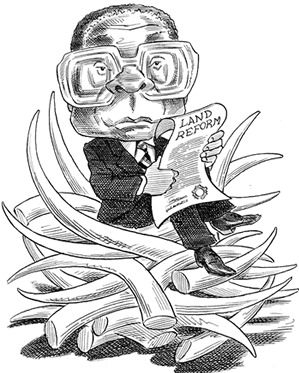- Energy & Environment
- Regulation & Property Rights
- International Affairs
- Law & Policy
 |
| Illustration by Taylor Jones for the Hoover Digest.
|
Recently reelected Zimbabwean president Robert Mugabe has clearly indicated that he has no intention of respecting property rights or the rule of law. His marauding militias (dubbed the “terror teens”) have terrorized opponents and brutally killed innocent people, and his “land reform” plan demands that more than 20 million of the 23.5 million acres under private ownership be surrendered without compensation. He has sent his thugs into the hinterlands, threatening farmers and pressing squatters to take over the land. Insecure property rights have left Zimbabwe’s economy in shambles.
Mugabe’s assault on private property has also taken a toll on wildlife, for without landowners there is no one to protect the animals from poachers. Before Mugabe’s attack on private property, Zimbabwe had demonstrated how wildlife could be privately protected. The Campfire Program, for example, championed by the World Wide Fund for Nature, allowed local communities to manage wildlife. Hence wildlife became an asset as villagers in communal areas profited from hunting and photo safaris. Elephant populations mush-roomed and poaching plummeted.
Stimulated by growing demands for hunting and tourism, private landowners also got into the wildlife business by combining small ranches into single units called conservancies, encompassing thousands of acres. The Save Valley Conservancy, for example, put together more than 850,000 acres for wildlife management and reintroduced rare species such as black rhinoceros and roan antelope. Throughout Zimbabwe, 64 percent of kudu, 63 percent of giraffes, 56 percent of cheetahs, and 53 percent of sable antelope and impalas were on private ranch properties.
Unfortunately wildlife is under siege by Mugabe. Photos of mutilated animals in the February 2002 issue of African Geographic paint a sickening picture, and the statistics tell the rest of the story. To clear the land, squatters have burned more than 60 percent of the woodland on the country’s three largest wildlife conservancies. The Bubiana Conservancy reports that 20,000 trees have been felled, 22 buildings razed, staff assaulted, and perhaps 50 percent of the wildlife killed. The Save Valley Conservancy reported more than 200 cases of poaching since August 2001 and the discovery of 5,677 snares. On the Chirendzi River Conservancy, where US$300,000 had been invested in improving wildlife habitat, 40 rare sable antelope and 200 large eland have been killed.
Poachers have also devastated smaller game ranches. Twenty-seven ranches in one region reported 2,761 animals killed and 26,292 snares collected. The value of animals lost is estimated at US$1.5 million. This value does not reflect the jobs—for whites and blacks alike—that will be lost as a result of the decline in wildlife populations.
The poor citizens of Zimbabwe cannot be blamed for trying to get their share of the land grab. Mugabe has duped them into thinking that land redistribution without compensation or due process is the key to economic prosperity. In fact, sustainable development will come only from stable property rights. Zimbabwe had previously shown the world how to balance economic development with conservation through private and communal ownership. Unless the sanctity of private property can be reestablished in Zimbabwe, its people and its wildlife will continue to suffer.







